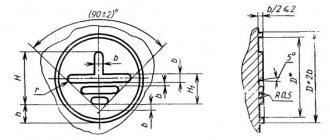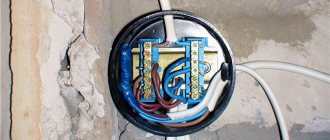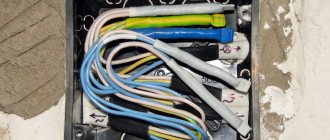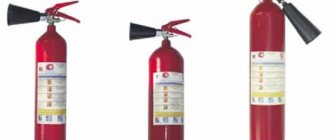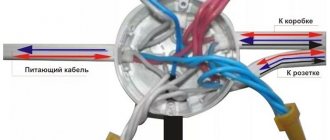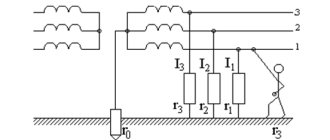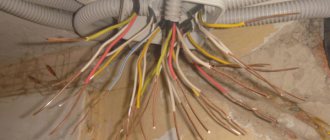In accordance with modern standards, the building where electrical wiring is installed must have a potential equalization system. Moreover, in addition to the main one, an additional SUP is installed. The organization of the latter (connecting a potential equalization box, etc.) will be discussed in this article. Let's start with the theory, namely, what SUPs are.
An example of organizing the main and additional SUP
Third party conductive part
A conductor that is not part of the electrical installation is called an extraneous conductive part.
A formal example is a metal door handle or hinge. You can focus on 2 principles according to which parts are selected for connecting to the additional potential equalization bus. The goal is not to make the system overloaded.
- The actual or potential possibility of communication with the “earth”.
- Possibility of potential appearance on a third-party conductive part in the event of an electrical equipment failure during operation.
The table below shows examples of third-party conductive parts that should or should not be connected to the additional potential equalization bus:
| Third party conductive part | Scheme | Connection required |
| A metal shelf mounted on a wall made of non-conductive material. | No | |
| Metal shelf mounted on a reinforced concrete wall. | Yes (potential connection to ground due to wall mounting) | |
| A metal shelf mounted on a wall made of non-conductive material. There is an electrical appliance on the shelf. | Yes (possibility of potential occurrence in case of failure of a device with insulation class I) | |
| Metal bedside table with rubber or plastic wheels on a concrete floor. | No | |
| Metal bedside table with rubber wheels on a concrete floor. There is dirt and dust in the room combined with high humidity. | Yes (potential connection to the “ground” due to pollution and high humidity) |
Issues related to potential equalization in bathrooms and shower rooms are regulated by Circular No. 23/2009.
One of the common questions: can tap water supplied through plastic pipes be a third-party conductive part? The said circular gives the following answer: “...Tap water of normal quality...is not considered as a third-party conductive part.” This means that such a possibility exists, at least due to the significant presence of various ferrous compounds in water. The circular recommends using conductive inserts on taps from water supply risers, connecting them to an additional potential equalization bus.
Lightning protection function
Basic SUP
Potential equalization in special structures designed to protect structures from lightning strikes is a serious measure that reduces the threat of fire at these facilities. In such systems, the dangerous potential difference formed due to the accumulation of charges of atmospheric electricity can reach enormous values - up to 15 kV.
Their arrangement is similar to the cases already considered, except that here an additional outlet is made, going to the grounding bus or the descent of the lightning rod. The cross-sections of the connecting conductors are selected based on the same calculation as for the general case of a BPCS device. According to the requirements of the PUE, not a single new electrical network, necessarily equipped with lightning protection, will be put into operation if it does not provide for artificial potential equalization.
Additional potential equalization system (DSUP)
An additional potential equalization system is necessary to provide additional electrical safety in areas with increased danger, for example, a bathroom or shower room.
P. 7.1.88. The PUE establishes that all touchable elements must be connected to the additional potential equalization system:
- exposed conductive parts of stationary electrical installations,
- third-party conductive parts (i.e. not part of the electrical installation) and
- neutral protective conductors of all electrical equipment (including plug sockets).
For bathrooms and shower rooms, an additional potential equalization system is mandatory and must include, among other things, the connection of third-party conductive parts extending outside the premises. If there is no electrical equipment with neutral protective conductors connected to the potential equalization system (i.e. with PE conductors, not to be confused with the working zero!), then the potential equalization system should be connected to the PE bus (clamp) at the input.
Heating elements embedded in the floor must be covered with a grounded metal mesh or a grounded metal shell connected to a potential equalization system. As additional protection for heating elements, it is recommended to use an RCD with a current of up to 30 mA.
It is not allowed to use local potential equalization systems for saunas, baths and shower rooms.
- exposed conductive parts of stationary electrical equipment;
- third-party conductive parts, including touchable metal parts of building structures;
- neutral protective conductors in the TN system and protective earth conductors in the IT and TT systems, including the protective conductors of socket outlets.
This system consists of the following elements:
- potential equalization boxes (PEC);
- potential equalization conductors.
The potential equalization box contains a PE bus, which is connected with a copper wire with a cross-section of 6 sq. mm to the PE bus of the input electrical panel (apartment, house). After this, by connecting to the PCC, all metal structures of the bathroom are grounded:
- heating;
- cold and hot water supply;
- bath (or shower).
Thus, the protective potential equalization conductors from grounded structures are laid with copper wire with a cross-section of 2.5-6 sq. mm and connected to the PE bus in the potential equalization box. The protective potential equalization conductors can be secured to the pipes using metal clamps.
All sockets installed in the bathroom are also subject to additional grounding.
The issue of ensuring electrical safety and implementing a system of additional potential equalization in bathrooms, showers and sanitary ware is discussed in detail in No. 23/2009, approved by the Deputy Head of the Federal Service for Environmental, Technological and Nuclear Supervision N.A. Fadeev. (letter dated 07/08/2009 No. NF - 45/2007) and approved by the President of the Roselectromontazh Association E.F. Khomitsky.
The purpose of the circular is to provide clarification on the implementation of a number of provisions of Chapters 7.1 and 1.7 of the PUE and specific recommendations for the implementation of individual elements of the system of additional potential equalization in bathrooms, showers and sanitary facilities and bringing them into compliance with new international requirements regulated by the IEC 60364-5-54 standard.
Requirements for conductors of potential equalization systems are specified in chapters 7.1 and 1.7 of the “Rules for Electrical Installations” (PUE) of the seventh edition.
However, at present, during the construction of buildings, plastic pipes in water supply systems have become widespread, and therefore additional questions have arisen regarding ensuring electrical safety in installations related to the likelihood of electric shock from a stream of water, water taps, faucets, heated towel rails and other metal elements of water fittings .
Note
Tap water of normal quality in terms of volumetric electrical resistance (conductivity) is classified as a semiconducting substance and, from the point of view of the possibility of electric shock, is not considered as a third-party conductive part.
Types of grounding devices
Grounding devices can be grouped as follows:
Natural grounding
Natural grounding devices include all structures permanently located in the ground:
- metal building structures and foundations;
- metal cable sheaths;
- casing pipes for artesian wells.
It is strictly forbidden to use the following as grounding conductors:
- gas pipelines and pipelines with flammable liquids;
- aluminum sheaths of underground cables;
- heating main pipes;
- cold and hot water supply pipes.
The natural grounding system requires at least 2 connections in different places.
Situations that arise in practice
The same thing happens in everyday life. A phase may occur on an electrical device due to damage to the insulation, the presence of moisture in the contact group, or failure of the power supply. If you touch a live device and at the same time touch a metal object in the room connected to the ground (for example, a pipeline), you may receive an electric shock.
When an electrical device is properly connected to grounding, a short circuit occurs on the housing, and automatic protection is triggered, disconnecting the circuit. In this case, there is no danger of electric shock, therefore the room is equipped with an energy supply system in accordance with the standards of the Electrical Installation Rules (PUE).
Another situation like this may arise. One of the neighbors in the building connected the neutral wire to the radiator (perhaps out of illiteracy, or perhaps in order to rewind the readings on the electric meter). A dangerous potential of 50 to 220 volts has arisen on the heating system. According to theory, the tension should remain in the ground where the steel pipes are laid. But if between any apartment and the basement part of the pipeline was replaced with plastic, the conductor will open.
The heated towel rail in the bathroom acquired a potential of, for example, 150 volts. When you touch it and a grounded washing machine, the same potential difference will occur, which is life-threatening. The problem is not with the electrical appliance, but with the heated towel rail, which is energized.
Here's another example. There is a power wire running through the wall of the apartment, and a water supply is laid nearby. Under load (when the boiler or electric oven is turned on), an EMF (electromotive force) may occur in the pipeline. The water flow is charged with a potential of up to 50 volts. This may not be a life-threatening voltage, but when you touch a faucet in the kitchen, you can feel electric shocks.
What bad things can happen
Electricians, as usual, cannot live in peace until they provide protection from all possible dangerous situations.
In fact, the two most dangerous emergency situations are possible:
- Voltage on the pipe - the body is grounded (potential drift),
- Voltage on the body - the pipe is grounded.
On various metal surfaces, voltage can appear not only due to breakdown of insulation, but also from the presence of static electricity or when induced or stray currents appear.
Let's consider the first case. Due to the potential difference, an accident may occur - current will flow from the pipe through the human body to the grounded body.
Current through a person from a pipe to a grounded body
What will happen to a person if he simultaneously touches the water supply pipe and touches the washing machine? To receive an electric shock, even a small potential difference between the machine body and the metal pipe will be sufficient.
The electric current will pass along a dangerous path - from one hand to the other. In either of the two examples described, current can flow through the heart and cause fibrillation (heart failure).
On the other hand, metal pipes for water supply or heating, as well as similar engineering systems, are usually grounded, that is, they have a potential equal to zero. And if for some reason a dangerous potential appears on the body of the washing machine, the current will flow conditionally in the other direction:
Phase on the body - the cause of current through a person to grounded objects
Why “conditionally”? Because the “direction” of the current, the reason and the flow pattern are not important. What is important is the fact of current flow and its meaning.
It is not necessary that one of the conductive parts must be grounded in order to create a critical potential difference (more than 50 V). It may happen that in relation to the ground there will be 50 V on the pipe, and 150 on the body of the washing machine. And here it is - a deadly potential difference of 100 V!
It may happen that the break occurs not after the tire, as shown with a cross in the picture above, but BEFORE - in or before the floor panel (where the word “PEN” is written in the picture). If the working and protective neutral conductors (N and PE) are connected after the break point (for example, in an entrance or apartment panel), then the phase potential will appear not only on the neutral, but also on the protective conductor. This means - on the housings of all grounded devices and structures. I talked about this in detail in the article What is the difference between a neutral break in three-phase and single-phase networks?
What can be done to prevent this unfortunate fact from happening? It is logical that for this it is necessary that there is no potential difference between those open conductive parts where it can appear.
What can happen will definitely happen. Moreover, even things that (seem) can never happen can happen.
We carry out installation
Installation of an additional SUP (also called local) is not difficult. It is advisable to do such work at the stage of major repairs, because... the wire from the box (KUP) to the panel must be routed in the floor screed. So, first you must prepare the following materials:
- Terminal box with a special copper bus - SHDUP, as in the photo below.
- Single-core copper wire, cross-section 2.5; 4 and 6 mm2. It is recommended to use wire PV-1 and PV-3.
- Fastening systems – clamps, bolts, contact tabs. Needed to connect conductors of potential equalization systems to pipes and metal cases.
Having prepared such a small set of DSUP, you can proceed to installation. First of all, it is recommended to draw up a potential equalization diagram, according to which you will connect all the elements. You can also sketch on the diagram where the wire will pass from the terminal box to the grounding bus in the panel. You can see examples of projects for an apartment in the plans below:
After this, you must prepare the communications for connection - clean the small area under the clamp on the pipes to a metallic shine. This is necessary so that the contact is reliable and the potential equalization system works in a dangerous situation.
Next, you need to connect each element with a separate wire. If there is no possibility of mechanical damage to the wire in areas, you can use a conductor with a cross section of 2.5 mm2 for equalization. When there is a possibility of damage, albeit insignificant, it is better to play it safe and use a wire with a cross-section of 4 squares. All wires are inserted into the PMC and securely fixed to the bus. By the way, it is recommended to choose a terminal box for installation in a bathroom with a protection degree of IP 54 or higher. A wire with a cross section of 6 mm2 is output from the bus, which must be laid to the apartment panel. There is also a specific requirement here - this conductor should not cross other cable lines, for example, if you decide to conduct electrical wiring in the floor.
Finally, the wire is connected to the grounding bus in the panel, which completes the installation of the additional potential equalization system. We recommend playing it safe and calling an electrician to check the functionality of the system with a tester and visual inspection!
It will be interesting to read:
- How to install electrical wiring in a bathroom
- How to deal with low voltage in the network
- How to make grounding in an apartment
Published: November 18, 2015 Updated: August 26, 2019
How to use it correctly
Despite their importance, potential equalization boxes require installation rules in places in a certain quantity. It is considered unsafe to install the system in the following cases:
- PMCs cannot be placed everywhere;
- old premises with combined neutral conductors;
- in the event of a break in the common grounding conductor without network boxes.
You may be interested in this Features of casings for wires
When equalizing potentials, yellow-green conductors, copper and stranded, are used. When connected to the busbar, they are protected from insulation. Connect to the conductor with crimping pliers using a special tip. A properly organized system does not require wiring to each device. The grounding conductor is responsible for this.
Before arranging the PMC, it is necessary to make a sketch with installation locations. The main thing is that you can easily get to each object under any circumstances. After determining the location, they think through the routes for the wires approaching the control panel. Each element must have a separate wire and be laid in a radial pattern.
Sketch for arranging PMC in a living space
Connecting conductors to the system is not a difficult and safe task. Grounding of pipes must be treated carefully, as a problem may arise in the form of current leakage. This problem can be corrected with the help of additional devices in the form of clamps, clamps, etc.
Important! The boiler, regardless of location (kitchen or bathroom), must operate through a control instrument (control and measuring device). Power is supplied via a separate line through an RCD.
To prevent short circuits on sockets when water gets on them, you need to use products with a class higher than IP5.
Installation of OSUP and DSUP is not a free service. It is carried out by specialists, namely electrical engineers. All costs of installing such a system are reimbursed by protection against electric shocks and proper operation of the equipment at high voltage and current leakage. You can do everything yourself, but there is a risk of missing important points, so you shouldn’t experiment.
Requirements
When installing the control unit, you must adhere to some requirements and rules:
- Its installation in bathrooms and toilets is mandatory. Firstly, these rooms contain a lot of metal bodies and surfaces. Secondly, there are a considerable number of electrical appliances here. Thirdly, these rooms always have high humidity.
- The box is installed in the place where the plumbing risers pass.
- It is necessary to connect all electrical equipment to which there is open access (this is, first of all, the housings of water heating boilers, washing machines), as well as third-party conductive elements.
- Access to the PMC must be free.
- Installation of the PMC is prohibited when the grounding is installed in the house without a grounding conductor (using the grounding method).
- The DSUP must not be connected via a cable.
- The DSUP along the entire length, starting from the control panel in the bathroom and up to the entrance panel itself, cannot be torn. It is prohibited to install any switching devices in this circuit.
Finally, I would like to say, do not confuse the concepts of equalization and equalization of different potentials. To equalize means to connect conducting elements electrically to make their potentials equal. And to level is to reduce the potential difference on the floor or surface of the earth (step voltage).
If you have little experience in electricity, then do not take on such work yourself, entrust it to professionals. Among other things, after completing the installation work, the specialist must also measure the grounding resistance and check the presence of a circuit between the grounding elements.
{SOURCE}
Installation of PMC with plastic batteries
During the installation of plastic pipes and multifunctional PMC equipment, metal taps and mixers must be added to them. Today, you can increasingly find metal-plastic pipes with dielectric inserts that are connected to the main circuit. The system, in turn, creates an equal potential for all metal devices in the building. If for some reason voltage arises on any of the objects, it will simply pass through the grounding conductor to the common circuit. Installation of the distribution box requires compliance with the following rules:
- Ensuring unobstructed access to the box.
- The PMC must be installed in the place where the risers pass.
- Installation of various systems, such as a bathroom, must be carried out without fail.
- For smooth operation of the system, you need to connect all open elements of electrical appliances, as well as third-party parts and protective conductors.
As in the previous version, it is advisable to install the equalization system during the construction of the house. If it is not available in old houses, then specialists will install all the necessary equipment step by step.
- § 1.19. electrostatic field potential and potential difference
It is always important to remember that before proceeding with the installation of the PCC, you need to carefully study the building's grounding system. After all, there are often cases when the installation of such equipment is simply prohibited
For example, if grounding was installed at the entrance without a special conductor, then installing a control system is simply impossible.
Why is additional potential equalization necessary?
Hot and cold water risers, heating risers, all these parts in the past were made strictly of metal. But as you know, metal has been replaced by plastic - polypropylene pipes. If earlier, when absolutely all pipes were made of metal and dangerous potential, accidentally ending up on a metal part, could flow into the ground without obstacles, then plastic does not provide such an opportunity. For example, you have metal risers, but your neighbor on the floor below changed them to plastic. Now the dangerous potential has nowhere to go. Holding a pipe on which a dangerous potential has accumulated with one hand, and with the other a riser that is grounded, this is exactly the case that can turn out to be fatal.
Additional potential equalization circuit
Additional potential equalization circuit
- How to protect a private house from lightning?
- How to connect wires in a junction box?
- What is the difference between grounding and grounding?
The main purpose of the PMC
The thing is that absolutely all metal objects are good conductors of current, and we all know this from physics lessons. In apartments and houses, such objects are presented in the form of hot and cold water supply pipes, drains, towel dryers, electrical appliance housings and even a ventilation duct. In any case, metal pipes and other communications are always interconnected.
If a difference in electrical potential occurs between two different objects, then touching them simultaneously can be extremely dangerous for a person. This is due to the fact that the body acts as a kind of bridge between two communications.
The most common case is when different potentials arise on the sewer and water pipes. It is worth noting that if a current leak occurs in the water supply pipes, then the likelihood of an electric shock while swimming will be extremely high. The main reason is the simultaneous touch of the faucet and the force of the water. By installing a potential equalization circuit in a timely manner, you will protect yourself and your loved ones from electric shock.
Exposure Hazard
The passage of current through the body when touching structural elements with different electrical voltage levels is dangerous to health and life. Here the body is a conductor of current from a point with a high potential to a point with a low voltage.
The dangerous characteristics of current are:
- frequency;
- force;
- path through the victim's body.
Alternating current is the most dangerous. It is noticeable already at a value of up to 0.6 mA. A current ranging from 0.6 mA to 0.025 mA has attractive properties due to its periodicity of pulses. A person cannot independently “unstick” from the points of contact. The limbs involuntarily contract, the body does not obey.
Current strength above 0.1 A causes fibrillation of internal organs and the heart and is fatal.
The direction in which electricity moves through the human body determines the level of harm to health.
Deadly routes of electric current:
- “hand - hand” - the bronchi, lungs and heart are affected;
- “arm – leg” – all internal organs suffer;
- “head - limbs” - both internal organs and the brain are affected.
Another path of harmful current movement is “leg-to-leg”. This is a “step voltage” that can occur when there is a current spreading across the surface in the event of a break in a live wire. In this case, the heart is not damaged if the person did not fall and did not change the points of contact with the source of danger.
Step voltage range
Danger
Remember from school? Any metal object conducts electric current. In our homes, similar items are everywhere. These are pipes of the central heating system, cold and hot water supply; batteries and heated towel rail; ventilation box and drain; metal body of any electrical appliance.
In general house communications, metal pipes are interconnected. Let's look at a simple example. We have a bathroom with a heating radiator and a shower stall nearby. If suddenly a potential difference arises between these two elements, and a person touches both the battery and the shower stall at the same time, it will be extremely dangerous in terms of electric shock. In this case, the human body will play the role of a jumper through which electric current will flow. The path of its flow is known to us from the laws of physics - from a potential with a large value to a smaller one.
Another typical example is if different potentials arise on water supply and sewerage pipes. When a current leak appears on a water pipe, there is a possibility of injury to a person while bathing in the bathtub. This will happen if a person stands in a bathtub with water, opens the drain and touches the water tap with his hand. To prevent such problems from arising, potential equalization is necessary.
The situation when there is voltage on the pipes in a residential building is shown in this video:
https://youtube.com/watch?v=Ume7hhDA5Zc
In order to equalize potentials, there are two systems, we will talk about each of them in more detail.
Basic adjustment
The main one is the basic potential equalization system; in its abbreviated form it is called OSUP. In essence, this system is a circuit that combines several elements:
- the most important is the main ground bus (GZB), it is on it that all other elements are connected;
- all metal fittings of a multi-storey residential building;
- lightning protection of the building;
- heating system;
- parts and elements of elevator facilities;
- ventilation box;
- metal pipes for water supply and drainage.
Each building has an input switchgear (IDU), and a main grounding bus (GZSH) is installed in it. It is connected to the ground loop using a steel strip.
Previously, there was no need to worry, all metal elements were combined, and there were no preconditions for different potentials. If any potential appeared on the pipe, it calmly went into the ground along the path of least resistance (we remember that metal is an excellent conductor).
Now the situation has changed; many residents, during renovation work in their apartments, are replacing metal water pipes with polypropylene or plastic ones. Due to this, the common chain is broken, batteries and heated towel rails are left without protection, because the plastic does not have conductive ability and is not connected to the grounding bus. Imagine that you still have metal pipes, and the neighbor below has changed everything to plastic. When potential appears on your pipes, it has nowhere to go; the path to the ground is interrupted by your neighbor’s plastic pipes. This is how a potential difference occurs.
The main system has a small problem. In multi-storey buildings, communication paths are very long, due to this the resistance of the conductive element increases. There will be a noticeable difference in the potential value on the pipes of the first and last floors, and this already poses a danger. Therefore, an additional potential equalization system is created and installed on each apartment individually.
Additional adjustment
An additional potential equalization system (abbreviated name DSUP) is installed in bathrooms and combines the following elements:
- metal body of a shower stall or bathtub;
- ventilation system, when its outlet to the bathroom is made of a metal box;
- heated towel rail;
- sewerage;
- metal pipes for water supply, heating and gas services.
And here you will need a potential equalization box. A separate wire (single-core, material made of copper) is connected to each of the above objects; its second end is brought out and connected to the PMC.
Selection of GZSh section
Let's look at the documents again. The PUE says that a bus installed in a switchboard room, that is, where there is access only for specially trained personnel, can be:
open - without any cabinets
must provide for the possibility of individual connection of all conductors
That is, no more than one conductor or tip is allowed under one bolt.
Regarding the dimensions, the PUE says that the cross-section of the GZSh must be no less than the PEN cross-section of the supply line conductor.
At the same time, the circular says a little differently. According to it, the GZSh section is selected according to the following table:
As you can see, here the choice is made not based on the PEN cross-section of the supply cable, but based on the phase conductor!
We all know that a Pen conductor can be either equal to a phase conductor or have a smaller size. For example, if you have a cable of 35 mm2 or more, then you have every right to take a cross-section for PEN that is half the size of the phase one.
Although most often the supply cable from the substation comes with the same cores (4*120mm2, 4*150mm2).
It turns out that if your cable is too thick, then according to the above table it is not at all necessary to select the same large copper busbar. The main thing is that it has a cross-section half the size of the phase conductor.
What to believe and how to assemble a panel board RShch-0.4kv? Since the circular is a kind of summary of the rules and clarifications of the PUE, then, of course, you can build on it.
But in practice, both situations should be taken into account. That is, make sure that your GZH meets both conditions:
not less than the cross-section of the phase conductor
and at the same time corresponded to PEN
In this case, there will be no claims against you regarding the grounding and potential equalization system.
It is not always clear who will accept the finished object. How competent he will be in his field. If you do what is called for yourself, then choose the most optimal and economical option, without looking at possible inspectors.
When calculating the cross-section, do not forget about the difference in materials and cable brand.
Power input cables are usually made of aluminum. And we decided to make the tire out of copper!
Accordingly, you will have to convert the useful cross-sectional area of aluminum to copper. The PUE tables for permissible long-term currents of copper and aluminum wires will help in this matter.
Look at the capacity of the aluminum cable and use this current in a similar table to select the cross-section of the copper bus.
For example, if you have an AVBbShv input cable 4*120mm2, then its PEN conductor has a cross-section of 120mm2 and a current I=295A.
For copper, this corresponds to a core cross-section of just over 70mm2.
Accordingly, you should select a copper busbar GZSh. A standard size of 4*30mm will be more than enough.
In this case, of course, you need to take into account the thickness of the mounting bolt. Otherwise, having drilled a hole for it, you may not have any useful area left for a snug fit of the tip.
In this case, choose a thinner tire, but somewhat larger in width.
Additional sizes of copper bars:
If you want to save money and choose steel rather than copper as the material for the gas shield, take data on currents from another table related to steel strip.
Here, as you understand, the sizes will already differ significantly.
And here is a ready-made table for selecting the cross-section of the main grounding bus for those who do not want to count anything and want to immediately get a ready-made result.
About potential difference
If the potential values of conductive objects in a room differ, then voltage (potential difference) arises between them, which poses a great danger of electric shock to humans
It is especially important to take this into account when connecting devices in rooms with high humidity (sanitary rooms, showers)
The difference in electrical potential between household appliances and pipes in an apartment may appear as a result of:
- current leakage due to damaged wire insulation;
- incorrect connection of electrical equipment;
- faulty electrical appliances;
- manifestations of static electricity;
- occurrence of stray currents in the grounding system.
In order to prevent potential differences from occurring in the room, a potential equalization system (PES) is implemented - a parallel connection of all metal structures located in the house. The basis of the control system is the integration of conductive objects into a single circuit.
The building provides for the installation of both a main grounding loop and additional potential equalization systems in accordance with the requirements of modern construction rules and regulations. The main system includes metal structures of the building: fittings, ventilation ducts, pipes, parts and elements of elevators and lightning protection.
Engineering communications have a fairly significant length, which increases the resistance of the conductors. In this case, the electrical potential of metal pipes on the top floors of a high-rise building is much greater than that of the pipeline on the first floors.
In addition, recently metal pipes have begun to be replaced with plastic ones. Thus, batteries and heated towel rails, which are made of metal, are deprived of protection, since plastic is not a conductor and has no connection with the grounding bus. Therefore, to solve such problems, an additional potential equalization system (DPES) is installed.
Causes
We all studied physics and remember that potential in itself poses absolutely no danger. You need to be wary of potential differences.
In apartments, potential differences between pipes and household electrical appliances may arise due to the following circumstances:
- The wire insulation is damaged and current leaks.
- Stray currents have arisen in the grounding system.
- The wiring diagram for electrical equipment is incorrect.
- Static electricity appears.
- Electrical appliances are faulty.
Additional control unit device
An additional system is often used in domestic premises. It includes the following components:
- Potential equalization box. It is equipped with a special terminal block intended for switching additional elements with conductive properties. The size of the PMC depends on the number of such elements. Most often, the box has standard dimensions of 100x100x50 mm.
- Electrical cables. For their manufacture, copper wire with a cross-section of about 2.5-6 mm is used. Aluminum conductors are not suitable for these purposes, since the thin film formed on them breaks the contacts and the use of the equalization system becomes useless.
https://youtube.com/watch?v=Ume7hhDA5Zc
Typical use case
To better understand all the principles described above, let's look at an example of using the main function of the EMS and its components. Let's imagine the following situation. The neighbors below or above you have purchased a washing machine. After working for quite a long time, it expired and broke down. All the wires are frayed, and the machine begins to electrocute. And since it is directly connected to the sewer pipes and has contact with water, the impacts can be felt by neighbors below or above the riser. As a result, you will get at least unpleasant sensations.
It is precisely to prevent them and ensure electrical safety in the house that a potential equalization box is used. It connects to the risers, the busbar in the electrical panel and every outlet in the bath or kitchen (in the bathroom). In conclusion, it is worth saying that a potential equalization system should be created during the construction of the building. However, it happens that such a network is simply not available on premises. In this case, it is urgent to correct the situation. After all, this is a rather serious moment. The potential equalization system is responsible for the electrical safety of the room and your health. Its installation must be carried out competently and professionally
Basic conditions for the box
PMC, as mentioned above, is installed wherever there are conductive networks. To carry out electrical installation you need to follow simple rules:
- The SHDUP box must be installed in bathrooms;
- it should not be limited. After installation, it is immediately brought into working condition.
Elements such as sockets, electrical equipment, switches are routed through the PMC to the control system.
Connecting the SUP
Note! It is preferable to use a hidden potential equalization box in the area of sanitary risers. Any electrically conductive surfaces (open and closed) and other electrical devices are connected to the general network.
You might be interested in Description of SIP wire 2x16
Installation of a potential equalization system for an apartment building (industrial premises)
Installation of system elements begins during the construction process. When creating the foundation, a metal bus is laid along the entire perimeter of the future structure. This is a closed conductor (steel strip or reinforcement) with welded branches for connection to grounding conductors, and for internal wiring of conductors. To ensure uniform spreading of potential into the physical ground, several groups of grounding conductors are installed along the contour of the building at an equal distance. If possible, equal distance is provided between them.
From the common bus, branches are made into each section (entrance), where the input power supply panel is installed. A grounding shield is formed, connected to a potential equalization system.
It is located in the panel room or in the basement. Access to the panel should be limited (unless it is a private house). Only representatives of the energy company, or state unitary enterprise, are allowed to perform maintenance.
Next, the wall reinforcement of the building is attached to the foundation bus.
The ceiling reinforcement is welded to the vertical elements of the system. If necessary, bus transitions are made from room to room.
After the walls are erected, a conductive busbar is laid along the outer wall for lightning protection installed on the roof. All these conductors are part of the potential equalization system.
Bends in the form of reinforcement or steel strips must be made into the shafts through which vertical pipelines (risers) are laid. After installing the water supply and sewerage systems, conductors are welded to the steel pipes to connect to the potential equalization system.
This means that the integrity of the potential equalization system has been compromised. It is recommended to duplicate the connection by simply connecting the grounding conductor to the grounding bus. This can be done using a contact clamp.
Tire design
To protect against the effects of potentials, the rules of the PUE provide standards for the installation of 2 systems - a general house and a local one. The first contains interconnected grounding circuits, the main protective bus, steel structures of the apartment and lightning protection structures. If the components are connected correctly, there will be no threat from potential differences.
Leveling bus
However, today many apartment owners equip their homes with plastic pipelines, which have now replaced steel ones. In the above embodiment, the main grounding circuit is broken. For this reason, due to the absolute impediment of current flow by plastic, a potential difference between different circuits can appear.
You may be interested in this Features of the Frls cable
Unsafe modes when a potential difference occurs include the fact that this difference grows significantly in proportion to the length of the section.
To correct the problem, an auxiliary stock of potential protection equipment is installed. The presented system includes an equalization box (KUP), which houses a tire (SHDU).
Note! The type of equalization complex is chosen based on a specific type of structure. Various steel structural components are attached to the above box, which include all in-house utility networks
The main difference between the additional system is that it provides protection in a single room.
Leveling and Leveling
Let's look at the basic concepts and terms:
- Potential equalization is the leveling of the difference in electrical potential values between the metal elements of an electrical installation in the room where the electrical installation is located, including the conductive elements of the building. In this case, a situation is considered dangerous when it becomes possible for a person to simultaneously touch conductive parts. It is achieved by non-disconnecting connection of all current-carrying parts to each other using conductors.
- Potential equalization is a system for reducing the relative difference in electrical potential between grounding, accessible conductive parts of electrical installations, the surface of the earth and all metal structures of the building. To do this, the potential equalization system must have an unbreakable connection with the working (protective) grounding conductor.
In addition, potential equalization includes reducing the electrical potential difference on the ground surface (floor, ceilings) to prevent the effect of step voltage.
What does the term "unbreakable" mean? All conductive lines are permanently connected to each other (contact blocks, screw connections, soldering, welding, etc.). It is not allowed to install disconnecting devices: fuses, switches, circuit breakers. That is, the entire potential equalization system is a single conductive circuit combined with a similar protective grounding circuit.
Thanks to these systems, in all points that a person can simultaneously touch, the electrical potential is equalized to the same value. The situation when, when touching at the same time, the voltage will be 220 volts at one point and 10 volts at another, is excluded.
Your home becomes absolutely safe.
Where is it often used?
Complex safety mechanisms are installed in rooms with electrical equipment to ensure the safety of working with electrically conductive devices. A potential equalization system is one type.
Potential equalization box (cup): installation and operating features
Mechanism of the potential equalization system
Where is the PMC used:
- at the stage of electrical installation of buildings, during construction work in multi-storey residential buildings;
- it is mandatory to install a potential equalization box in the bathroom;
- Outdoor installation is provided.
The electrical safety of premises largely depends not only on the devices, but also on the potential equalization system
This review focuses on the importance of this process when using electrical equipment
Places of application
Note! The main function of the EMS is to protect a person from electric shock in places with an increased probability of such an event. This could be the kitchen or bathroom
Places with high humidity need to install such a system for calm washing of dishes or taking a shower.
Purpose and device of SHDU
Cause of electric shock
The additional electrical potential equalization system covers the following mandatory elements:
- Without exception, all devices located in rooms with high humidity - in bathrooms, kitchens, basements and attics of private buildings - and subject to grounding.
- Elements of metal structures directly adjacent to these premises and extending beyond their planning boundaries.
- Neutral conductors of the grounding system. All other equalizing bends are connected to them.
If there are no neutral N conductors on this branch, the entire system is connected to a PE bus installed in the distribution cabinet at the entrance to the building.
This procedure also applies to heating tires of the “warm floor” system, tightly embedded in concrete coverings. Before installing them, you will need to cover the set of steel tubes with a metal mesh, which is subsequently connected to the system in which the SHDU bus is provided. To provide additional protection in the power supply circuits of heating devices, it is recommended to install an RCD for a current of up to 30 mA (see clause 7.1.88 of the PUE).
Methods for connecting elements connected to U4 type SHDU buses are very different. The following typical schemes are widely practiced:
- radial connection method to potential equalization elements;
- connection with a loop that ensures continuity of the equalization circuit.
DSUP conductor parameters
DSUP
Only conductors specially designed for this purpose are suitable for the additional potential equalization system. According to the provisions of the PUE (see clause 1.7.138), their characteristic dimensions must satisfy the following requirements:
- when connecting two own conductive parts of the equipment, the cross-section of the smaller of the protective conductors connected to the grounded parts is selected as the main one;
- when connecting own and third-party conductive elements of equipment or devices, half the cross-section of the protective conductor connected to the open part of the ground loop is taken as a basis.
- it should be equal to 2.5 mm2, subject to reliable mechanical protection from deformation and other extraneous influences;
- its value reaches 4 mm2 in the absence of the necessary security.
The general scheme of the DSUP, in addition to all of the above, includes elements of protection against lightning and lightning discharges.
Types of leveling systems
Potential equalization busbar with plastic support
Equalization systems used in electrical networks are divided into basic and additional devices. To understand their differences, you will need to consider each of these approaches separately.
Main system
This type of leveling structures is abbreviated as OSUP. At its core, it is a circuit assembled from metal plates and combining the following elements into a single whole:
- main grounding bus (GGB), designed for assembling all elements to be grounded;
- metal fittings of a residential building or other building;
- elements for protecting buildings from thunderstorms and lightning;
- heating pipes and radiators;
- metal ducts of ventilation systems;
- water supply and sewerage pipes.
Usually, for the installation of the main switchgear, a separate seat is selected in the input distribution cabinet (IDU). In its absence, any metal assembly is used for this purpose, from which a branch is made to the ground loop using a steel or copper strip.
Additional alignment
Potential equalization
The additional potential equalization busbar ШДУП is a special steel structure mounted for the purpose of electrical connection of the following elements located in a wet room:
- the body of the shower stall and the bathtub itself;
- conductive parts of the ventilation system, if the entrance to the bathroom is framed with a metal box;
- sewer pipes;
- unit body for drying towels;
- water pipes and heating radiators, as well as all other parts that require grounding.
For an additional potential equalization bus, you will need to install a special cabinet or metal box from which copper conductors are pulled to each of the listed objects. Such a system is considered as auxiliary, that is, complementary to the BPCS. This explains the impossibility of their separate use and operation.
Why do you need to equalize potentials?
Before considering this system in detail, you should understand the concepts of electric potential and current. Their physical properties are clearly visible in the example of a conventional conductor. When it is at rest, all charged particles - positive and negative - evenly fill its internal structure.
Each current source has an insufficient number of electrons at one of its poles, and an excess number at the other. When a conductor is connected to it, all the electrons inside will move in a certain direction in order to equalize this deficiency and excess. This movement is called electric current, and the difference in electrons is known as positive and negative electric potential.
With a constant potential difference, the electrons will move in one direction, so the current is considered constant. If there is a frequent change of places of positive and negative potentials, then such a current will be called alternating. In a home network, such changes occur 50 times per second, that is, the AC frequency is 50 Hz.
All conductors through which electric current flows are protected by insulation, preventing any contact with surrounding objects. This applies to all metal elements, parts and structures that have zero electrical potential and through which no current should flow. Ideally, they all work autonomously and do not pose a danger to others.
However, quite often situations arise, in an apartment or in a private house, associated with current leaks. For example, as a result of an accident, a live wire and a battery came into contact. In this case, the current penetrates the entire heating system, which leads to a change in the electrical potential of the metal radiator.
Such a situation can lead to various options for further developments:
- A man stands on the floor wearing non-conductive shoes. In this case, nothing will happen and there will be no electric shock.
- When standing on a grounded floor, a person inevitably receives an electric shock. For such situations, an RCD is provided - a residual current device.
- A person stands on an insulated floor while simultaneously touching a metal pipe and a live battery. Each of these structures has a different electrical potential and current will begin to flow through the body. It is at this moment that a person receives an electrical injury. To combat this phenomenon, a potential equalization system is provided.
For this purpose, all types of metal elements and protection of devices and equipment that should not be energized are connected into a single circuit. In the event of an emergency, they will all have the same potential
Even if the voltage is 220 volts, no electric shock will occur; it is important that there is an insulated surface under the person’s feet
What is electric potential and potential difference
For clarity, we can clearly consider two metal coins, which are heated to different temperatures, using a simple example:
- Т1 = 100 ̊С;
- Т2 =70 ̊С.
ΔТ = 100 – 70 = 30 ̊С – the temperature difference will be 30 degrees.
If you connect coins, heat will begin to move: the more heated one will give off heat and cool down, the less heated one will receive heat and warm up more. Thus, heat exchange occurs until the temperature on the two coins is equalized.
In our case, we are considering electric potential, coins or other objects can be charged with an electric charge, in this case not heat, but charged particles will move from a larger charge to a smaller charge, and the potentials will equalize to a balanced state of charges. Thus, an electric current is temporarily generated.
Concept of potential
In the international SI measurement system, electric potential is measured as the work done by an electric field to move a positive charge from a certain point in the magnetic field to an infinite distance.
The magnitude of the potential is measured in volts:
1B = 1J/1C, where:
- J – magnetic field energy, measured in Joules;
- C is the amount of charge, measured in Coulombs;
The difference between the potentials of two charges, as in the case of heating coins, will be:
ΔB = 100V – 70V = 30V.
Potential difference equation
The potential difference in electrical circuits between two conductive surfaces, most often wires, electrical installation housings, water pipes, grounding bars, is called voltage and is designated by the letter “U”.
Without going into details of physical processes, it is taken as an axiom that in industrial electrical circuits the earth is taken as an object with absolutely zero potential. Therefore, the voltage in the circuit is measured relative to the ground loop.
Basic potential equalization system
The main potential equalization system (BPES) combines all large current-carrying parts of the building, which normally do not have electrical potential, into a single circuit with the main grounding bus. Let's consider a graphic example of implementing a control system in an electrical installation of a residential building.
Potential equalization system in a residential building
According to the above diagram, the BPCS consists of the following elements:
- grounding loop (grounding device);
- main grounding bus (GZSh);
- zero protective conductors;
- potential equalization conductors.
The list of conductive parts in electrical installations up to 1 kV, subject to connection in the OSUP, is defined in clause 1.7.82 of the PUE. The main grounding bus can be installed inside the input distribution device or separately, subject to the following conditions: location near the protected object, provision of access for its maintenance and mandatory protection from possible contact. Inside the input distribution device, a PE neutral protective conductor bus is used as a main shield, which ensures not only the connection of the protective zero of the incoming supply line with the neutral conductors of the building's distribution network, but also performs the function of connecting individual conductive parts and grounding devices. A separately located bus connects only the current-carrying structures and grounding conductors included in the OSUP. The cross-sectional area of such a main shield must be no less than the cross-sectional area of the neutral protective conductor of the incoming supply line. The main grounding bus is made of copper, steel can also be used. A grounding loop and neutral protective conductors (PEN or PE, depending on the selected grounding system) are connected to it. The metal parts and structures of the building, as well as the communications and ventilation system related to it, are mounted to the main building in a radial pattern, connecting each conductive element with a separate potential equalization conductor, with the possibility of disconnecting any of them. Conductive parts of communications entering the building from the outside must be connected to the main building as close as possible to their entry point. The connecting conductors of the OSUP are subject to increased requirements, the main one of which is their continuity. Therefore, the installation of various switching devices in circuits is strictly prohibited. The conductors are yellow-green in color and must have a tag with the name of the connected element. They are secured to the busbar with bolted connections, they are also attached to conductive structures by welding, and clamps are used for communication pipes. The cross-section of potential equalization conductors must be at least: 6 mm 2 for copper, 16 mm 2 for aluminum and 50 mm 2 for steel. see clause 1.7.137 PUE.
Why do you need SOUP?
To prevent such dangers, the potentials should be equalized. For this purpose, the Potential Equalization System (CPS) is used.
According to clause 6.1.1 SP 437.1325800.2018 :
When designing each electrical installation of a building, provision must be made for protective potential equalization, which usually includes a main potential equalization system and, if necessary, an additional potential equalization system . Under appropriate conditions, it may be necessary to use local potential equalization .
According to clause 1.7.32 of the PUE:
Potential equalization is the electrical connection of conductive parts to achieve equality of their potentials. Protective potential equalization is potential equalization performed for electrical safety purposes.
According to clause 1.7.51 of the PUE , potential equalization is a measure of protection in the event of indirect contact (in case of insulation damage or other emergency). It also says that it is advisable to use equalization in conjunction with other protective measures (my interpretation).
The principle of operation of the potential equalization system is to connect various conductive parts that a person can touch to the neutral protective conductor (PE). The “conductive parts” referred to in the PUE are the housings of electrical appliances, pipes, and various metal structures. In addition, concrete floors in which an electric heated floor is embedded also fall under this requirement. But this is no longer equalization, but equalization of potentials .
Yes, all these conductive parts are not normally energized and do not pose a danger. But, if during any accident (for example, deterioration of insulation) they come under dangerous voltage, then there will be trouble - they will conduct current not only through themselves, but also through anything, including the human body. Therefore, in advance (yes, electricians are still pessimists) all current-carrying parts are connected by PE conductors to a PE bus - this is the shortest and “convenient” distance for dangerous current to flow to the ground electrode.
According to clause 3.28 of SP 437.1325800.2018 and article 3.15 of GOST IEC 61140-2012 :
Hand Reach Zone: The zone of accessible touch extending from any point on a surface on which a person normally stands or moves to the limit that he can reach with his hand in any direction without the use of aids.
In ordinary household wet and damp rooms, the reach zone is the entire room. It is important that within the reach zone there is not a single object left capable of conducting current that is not connected by a protective grounding wire to the control system and, ultimately, to the main generator.

